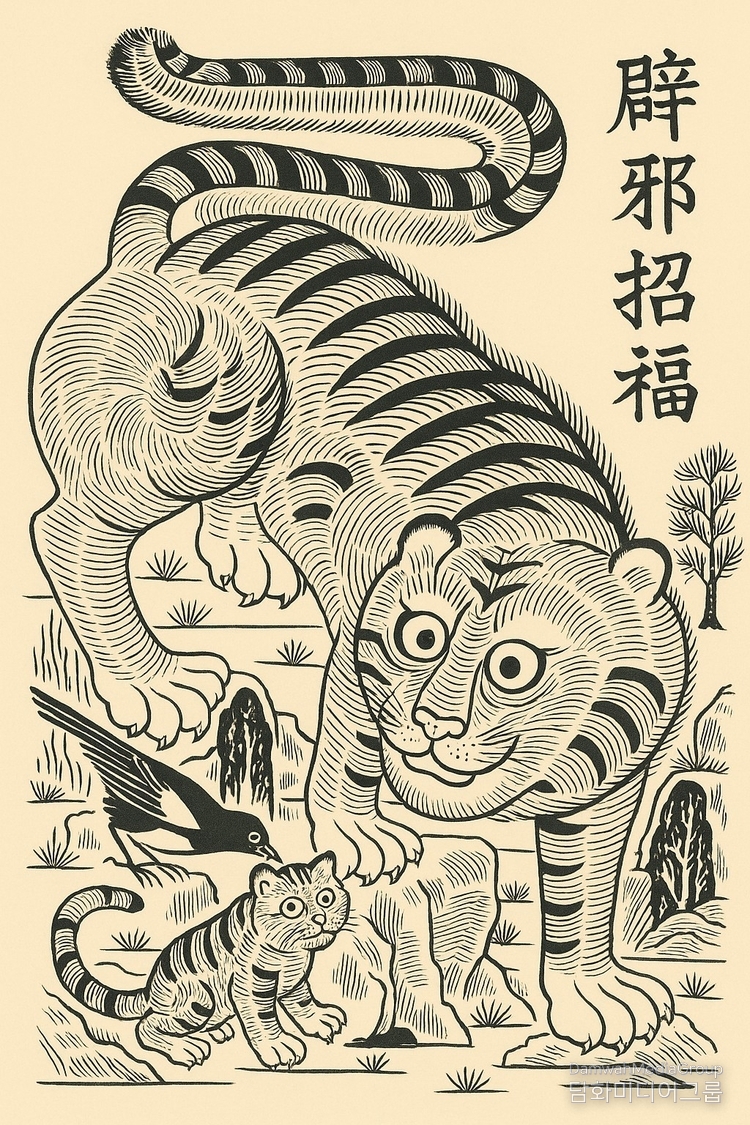By UN Journal Lee Jon-young
Tigers in Joseon Dynasty folk paintings always bore two faces. The majesty of the mountain's lord and the face of a friend who brings laughter to the people.
“The tiger of Byeoksachobok (辟邪招福)” painting perfectly harmonizes these two faces. Even within its round, humorous eyes, a living energy flashes in every stroke. These lines are not mere decoration; they are the lines of a spell to repel evil spirits and invite good fortune.

It is the very talisman of folk painting. On the right side of the painting, the four characters ‘Byeoksachobok (辟邪招福)’ are clearly inscribed. This phrase symbolizes the talismanic practice of “warding off evil and inviting celebration” (辟邪進慶) that commoners of the Joseon Dynasty would affix above their doors or on the walls of their main halls. The tiger was revered as a guardian deity chasing away evil spirits, while the magpie was seen as an auspicious bird bringing blessed tidings.
Thus, this single painting visualizes the people's prayer to ‘ward off calamity and welcome happiness.’ Within it, the Buddha's grace and the people's faith are naturally infused. Seriousness within humor, the conversation between magpie and tiger: The magpie in the painting seems to be teasing the tiger, while the tiger rolls its large eyes, appearing to smile faintly.
Hidden within this playfulness is satire mocking the relationship between power and the people. The laughter in folk paintings was not mere amusement, but the freedom of the spirit seeking to transcend oppressive reality. Thus, this tiger is not frightening. Rather, it is warm. Its presence carries not fear, but an aura of peace.
The lines of practice, the breath of faith, the lines of the restored woodblock print are not uniform. Yet this very unevenness gives it vitality. The lines carved repeatedly with the tip of a knife are like the breath of the practitioner, imbued with prayers for the peace of the household. Each stroke in folk painting is not mere form, but the knot of faith and the trace of aspiration.
The tiger as a Buddhist symbol embodies the worldview of ‘warding off evil and bringing good fortune,’ aligning with Buddhism's concept of protective mantras. The concept of the god of protection, who repels evil spirits and bestows blessings, is transformed into the tiger within folk paintings. Thus, this tiger is both a mountain spirit and a god of protection, a guardian Buddha safeguarding blessings beside the people. Consequently, this painting can be seen as the crystallization of ‘Buddhist aesthetics in daily life,’ where religion and art, faith and humor coexist.
The four characters ‘辟邪招福’ (Warding off evil and inviting blessings), an icon of peace guarded by laughter, are not merely words wishing for fortune. They embody a philosophy of life and a direction for practice: repel evil, but invite blessings yourself. With hearts as strong as the tiger's gaze and as clear as the magpie's song, we advance today toward a world of peace and blessings.
※ The copyright holder of this work is Damwhachongsa. Unauthorized use, reproduction, or distribution is prohibited.






